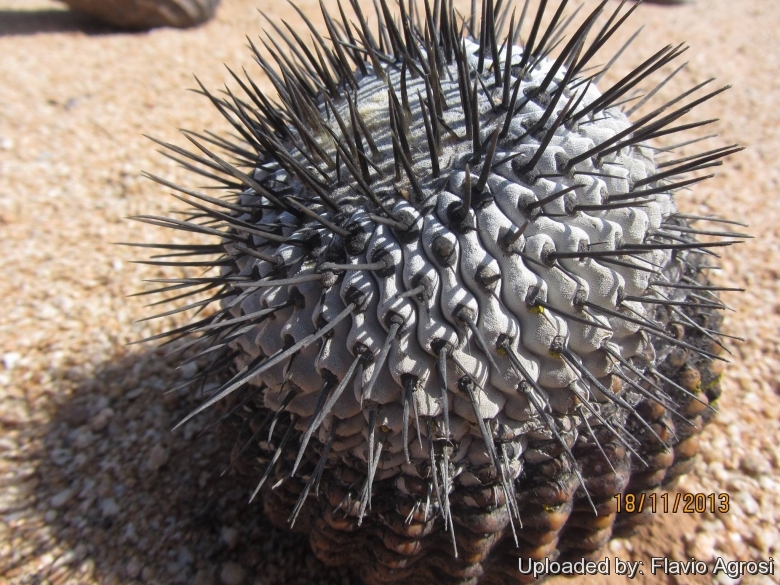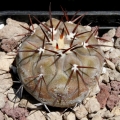Accepted Scientific Name: Copiapoa cinerea (Phil.) Britton & Rose
Cactaceae (Britton & Rose) 3: 86. 1922 [12 Oct 1922] Britton & Rose

Copiapoa melanohystrix Photo by: Flavio Agrosi
Copiapoa melanohystrix should be distinguished by its more long and stout black spines and blackish felted areoles that give the plant a very intriguing dark overall.
Origin and Habitat: Esmeralda and adjacent areas.
Altitude: 300-600 metres above sea level.
Habitat: It grows in areas where very little else grows. It's a very drought tolerant species. Despite the lack of rain where it lives, the extreme aridity is attenuated by the frequent, often dense, coastal fogs. The fog tends to shows a recurrent pattern; usually it is overcast in the early mornings, the clouds dissipating during the late morning and returning during the late afternoons. Even though the temperatures are moderate in the summer as well, the light on sunny days is so bright and burning that most Copiapoas are covered by a white waxy surface which protects the plants from the sun and reduces the evaporation. The wax gives the plants a characteristic, whitewashed look. The waxy coating is only created if the plants are exposed to ultraviolet rays and will only be created sporadically under glass in a greenhouse.
Synonyms:
See all synonyms of Copiapoa cinerea
Description: Copiapoa melanohystrixSN|1380]]SN|9773]] is one of the many forms of the very variable Copiapoa cinereaSN|1383]]SN|1380]]/Copiapoa columna-albaSN|9773]]SN|1383]] complex. It is still unclear whether this variable complex is one or several species. There is so much variation that most authors choose to lump them together. Copiapoa melanohystrixSN|1383]]SN|9773]] should be distinguished by its more long and stout black spines and blackish felted areoles that give the plant a very intriguing dark overall. It can be referred to a form or clonotype within the variability of Copiapoa columna-albaSN|1380]]SN|1383]]. This form is more decorative than the standard Copiapoa cinereaSN|9773]]SN|1380]] and one of the showiest of all cacti.
Habit: Usually solitary, forms white columns with dark contrasting spination.
Stem: Variable 50-75 cm tall, 10-20 cm in diameter, epidermis covered with a thick stratum of ashy-white pruine. Apex flattened with abundant dark-grey wool and without spines.
Ribs: 27-47, depressed, obtuse and tuberculated, approx 1 cm wide, 5-7 mm tall. Inter-ribs suture wavy.
Areoles: Small (diameter 2-3 mm), oblong, with yellow-orange wool (later becoming grey) recessed within the lower part of tubercle, 4-8 mm apart.
Central spines: 1-3 sub-erected, strong, more than 2 cm long, black.
Radial spines: 4-5 thin and arching, 5-8 mm long. Normally not present in adult specimen.
Roots: Not napiform.
Flowers: Diurnal closing at night, protracting the period of opening many days and arising on the crown, often several at a time, funnel form, small (2-3 cm long), yellow, scentless.
Fruit: Deeply concealed within the apical wool, round or egg-shaped, pale green reddening toward the apex, almost naked with only few (3-4 mm long) scales. Almost completely dry at maturity.
Seeds: Shining-black.
Bibliography: Major references and further lectures
1) Edward Anderson “The Cactus family†Timber Press, Incorporated, 2001
2) James Cullen, Sabina G. Knees, H. Suzanne Cubey "The European Garden Flora Flowering Plants: A Manual for the Identification of Plants Cultivated in Europe, Both Out-of-Doors and Under Glass" Cambridge University Press, 11/Aug/2011
3) David R Hunt; Nigel P Taylor; Graham Charles; International Cactaceae Systematics Group. "The New Cactus Lexicon" dh books, 2006
4) N. L. Britton, J. N. Rose “The Cactaceae. Descriptions and Illustrations of Plants of the Cactus Family.†Volume 4, The Carnegie Institution of Washington, Washington 1923
5) Urs Eggli, Leonard E. Newton “Etymological Dictionary of Succulent Plant Names†Birkhäuser 2004.
6) F.Ritter “Kakteen Südamerika†3: 1072 1980.
7) Graham Charles “Copiapoa†Cirio Pub. Services, 1999
8) Adriana Hoffmann “Cactáceas en la Flora Silvestre de Chile†1st edition, 1989
 Copiapoa melanohystrix, Chile Jannuary 2018. Photo by: Raimondo Paladini
Copiapoa melanohystrix, Chile Jannuary 2018. Photo by: Raimondo Paladini Copiapoa melanohystrix Photo by: Flavio Agrosi
Copiapoa melanohystrix Photo by: Flavio Agrosi Copiapoa melanohystrix Photo by: Flavio Agrosi
Copiapoa melanohystrix Photo by: Flavio Agrosi Copiapoa melanohystrix, Chile Jannuary 2018. Photo by: Raimondo Paladini
Copiapoa melanohystrix, Chile Jannuary 2018. Photo by: Raimondo Paladini Copiapoa melanohystrix Photo by: Flavio Agrosi
Copiapoa melanohystrix Photo by: Flavio Agrosi Copiapoa melanohystrix, Chile Jannuary 2018. Photo by: Raimondo Paladini
Copiapoa melanohystrix, Chile Jannuary 2018. Photo by: Raimondo Paladini Copiapoa melanohystrix, Chile Jannuary 2018. Photo by: Raimondo Paladini
Copiapoa melanohystrix, Chile Jannuary 2018. Photo by: Raimondo Paladini Copiapoa melanohystrix juvenile specimen. Photo by: Valentino Vallicelli
Copiapoa melanohystrix juvenile specimen. Photo by: Valentino VallicelliCultivation and Propagation: Considering that Copiapoa melanohystrixSN|9773]]SN|9773]] comes from a habitat with an extremely arid climate, they are remarkably tolerant of pot culture. These plants have taproots and are susceptible to overwatering. They requires also an appropriate air circulation. Copiapoas are summer grower species easy to cultivate.
Growth rate: This is a slow growing cactus kept for the beauty of its form that will make clumps given the best conditions.
Soils: It likes very coarse mineral cactus mix soil, but can become too elongated if compost is too rich.
Repotting: Use pot with good drainage.
Watering: It requires light but regular waterings in summer, but let the soil mix dry between waterings, but do not overwater (Rot prone), it must be strictly kept dry throughout the winter quiescent period since it is very sensitive to any moisture excesses keep dry in winter.
Fertilization: Feed with a high potassium fertilizer in summer.
Hardiness: Not highly tolerant of a great deal of frost. They need to be kept in a cool place during winter rest and are resistant to light frost if kept on the dry side prior to, and during, cold weather ( they are hardy to -2 C ° C short periods). However some warmth throughout the year will increase the grower's success (minimum 5° to 10°C during rest season).
Exposition: Requires full sun or light shade and careful watering to keep plant compact with strong coloured spines. Tends to bronze in strong light, which encourages flowering and heavy spine production. Light shadow my be useful in the hottest summer days.
Uses: It is an excellent plant for container growing. It always looks good and stays small. It look fine in a cold greenhouse and frame or outdoor in a rockery.
Pests & diseases: It may be attractive to a variety of insects, but plants in good condition should be nearly pest-free, particularly if they are grown in a mineral potting-mix, with good exposure and ventilation. Nonetheless, there are several pests to watch for:
- Red spiders: Red spiders may be effectively rubbed up by watering the infested plants from above.
- Mealy bugs: Mealy bugs occasionally develop aerial into the new growth among the wool with disfiguring results, but the worst types develop underground on the roots and are invisible except by their effects.
- Scales: Scales are rarely a problem. It is wise to treat your whole collection with a systemic insecticide twice a year in spring and autumn.
- Rot: Rot is only a minor problem with cacti if the plants are watered and “aired†correctly. If they are not, fungicides won't help all that much. To prevent rottenness it is also advisable to surround its root neck by very rough sand or grit, this help a fast water drainage.
Propagation: Seeds (or offsets if available), Grafting is often used to speed growth rate and to create a back-up to plants in collection. Seeds germinate in 7-14 days at 21-27° C in spring, remove gradually the glass cover as soon the plants will be well rooted (ca 1-2 weeks) and keep ventilated, no full sun for young plants!
Your Photos

by Flavio Agrosi

by Valentino Vallicelli




















